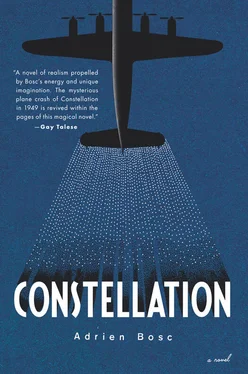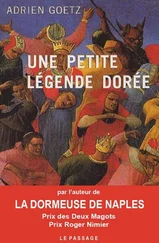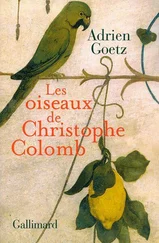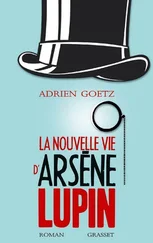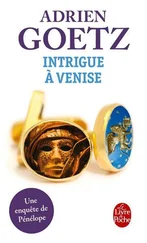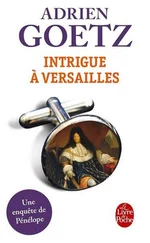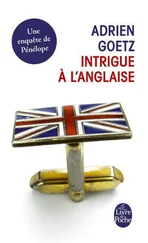Toward enchanted flutes
While cruel hopes pierce
With daggers and darts
An innocent heart
10. From One Accident to Another
A succession of events, interconnected,
that would cancel each other out.
— Georges Perec, Life, a User’s Manual
One tragedy can hide another. When Jenny Brandière returned to France in June 1949, it was to rush to the bedside of her daughter Françoise. During the early summer in Havana, there had been nothing to suggest the tragic events unfolding in Paris. Françoise was studying for her degree in Spanish at the Language Institute and had been living for the past year in the family apartment on the boulevard Malesherbes in the 17th Arrondissement, not far from the avenue de Wagram and the parish of Saint Francis de Sales. It was the summer she turned twenty-one. Coming back from a party that her cousins gave outside Paris, the Citroën Traction Avant 11 CV driven by her friend Gérard slammed full tilt into a roadside tree, unmoving beyond the shattered windshield, the mangled hood, bending the chevron insignia back to the wheels, smoke pouring out against the wounded trunk, the two passengers ejected. Françoise was taken to the hospital in critical condition, comatose from cranial trauma. Her older sister, Monique, her aunt, Denise, attended her between life and death. It was generally believed that she had no chance. A string of emergency surgeries was performed. Both legs were shattered. In the hallway, sitting on a stool, his features drawn, was a family friend, the conductor Charles Munch.
Notified immediately, Jenny Brandière took the next flight from Havana to Paris, pausing in New York. The prognosis was still uncertain when she arrived. Watching her daughter’s unconscious form, Jenny vowed to bring her back to Cuba. A few days later, Professeur Puech called for a trepanation, and once the hematoma was evacuated the patient came out of her coma. The operation had been a success, she returned gradually to life. Transferred to the Diaconesses Clinic, she underwent a long and painful convalescence, the visits growing progressively longer, the fragments of words becoming sentences, discussions, questions, answers. She would always limp. In August, she took her first walks at their country house in the Yonne. She asked to return to the site of the accident, a snapshot showed her at the foot of the tree wearing the smile of a survivor, carrying a cane, treading on the grass at the edge of the county road. In September, she returned to the apartment on the boulevard Malesherbes. They decided not to enroll her at the university for the year ahead. She would leave for Cuba in early November. On the far side of the world, a husband and father, Jean Brandière, ill, moved up the departure date. It would be October 27.
In 1899, with six hundred dollars in his pocket, Albert Brandière disembarked in what was still only a Spanish colony and created an import-export business in Cuba for French goods. In his suitcase, between two shirts, suspenders, and socks, were the flagship products of the Guerlain and Vichy brands, a leather shop front for an industry he hoped to import. Through good years and bad, the business grew, gradually narrowing its activities to represent French pharmaceutical products. Brandière Laboratories packaged the raw material and made a line of medicines from Old Europe available in Havana. In 1927, the eldest son, Jean, was chosen to lead the business. September 1939, the sound of boots was echoing from continent to continent, the Brandières were returning to France aboard a ship flying the American flag. A reserve officer in the French Army, Jean was imprisoned. Two years in Oflag XIII, the father of four, he was released. Back in Paris, weakened by renal tuberculosis, not forgetting his companions in misfortune who remained in Germany, he joined the Red Cross, working actively for their repatriation. The German surrender prompted the family’s return to Havana, the only thing left of the laboratory being the Brandière name in mosaic on the doorsill, dust and broken glass carpeting the once sparkling tile of the prewar lab benches. Jean took out multiple loans, got the business running again, and continued Albert’s work.
Cuba now became a brothel and casino to the United States. Under the leadership of Lucky Luciano and his project manager, Meyer Lansky, Havana, a state within a state, became the playground of the Italian-American Mafia. Headquarters were at the Hotel Nacional. Over Christmas 1946, Lucky Luciano, just out of prison, organized a great gathering of the crime world there. A Bretton Woods Conference with a Mafia accent, one thousand people in attendance, including the Capone cousins Charlie, Rocco, and Joseph Fischetti, who arrived by plane with Frank Sinatra in tow. On the agenda: controlling the island’s casinos, liquidating the debt-ridden Bugsy Siegel, arbitrating the struggle between Albert Anastasia and Vito Genovese — and, as a cherry on top, Lucky Luciano, capo di tutti capi , announced his removal to Italy, once and for all, to Naples. A prosperous and corrupt Cuba. In 1947, Fidel Castro was still a young law student, the opening gambits of the revolution were taking shape in the Dominican Republic, site of the first engagements against the dictator Trujillo. And in October 1948, Fidel married the sister of the minister of the interior, the Cuban regime’s strongman, who a few years earlier had sided with the Americans against the French over control of the banana industry.
At Brandière Laboratories, the Cuban Revolution is still far in the distance. On October 27, 1949, Jenny and Françoise’s trunks are loaded into a taxi bound for Orly Airport. Mother and daughter are returning to Havana.
They scan the heavens lusting for the coin
That looting the cargo bay would earn.
— Serge Gainsbourg, “Cargo Cult”
The newspaper France-Soir sometimes printed as many as seven editions in a day. In the fourth edition of Friday, October 28, 1949, Pierre Lazareff’s paper publishes a special section on the tragedy in the Azores and replays the “film of the wait”:
9:26 a.m. — Air France announces great anxiety over the fate of the airplane carrying Marcel Cerdan and thirty-six other passengers; “Search operations were immediately undertaken by air and sea. As of 9 a.m., nothing has been found.”
9:50 a.m. — First detail. The Constellation transmitted its last message at 3:55 a.m.: it was then preparing to land in the Azores. No word has been heard since .
10:15 a.m. — An Air France spokesman says that the loss of contact with the plane may be the result of technical difficulties: the atmospheric conditions are unfavorable to radio transmission .
10:25 a.m. — Paris is maintaining an open line with the Portuguese islands, and it can be stated with fair certainty that the plane did not land on Santa Maria .
10:50 a.m. — According to an announcement from Orly Airport, the plane went down at sea off the Azores .
11:30 a.m. — No trace of the aircraft. A slight hope survives — though the chance is slender — that the plane landed on one of the archipelago’s smaller islands. It is known that at the time of its approach to the Azores airfield, the craft still had fuel for four hours of flight. Its equipment includes rubber rafts, and if it was forced down at sea the passengers and crew may yet be rescued .
12:10 p.m. — Orly announces that the plane landed seven minutes away from the Santa Maria airfield. Within minutes, Air France rebuts the statement .
1:13 p.m. — News flash: wreckage from the Paris — New York flight has been found by a search plane on the summit of Mount Algarvia, on the island of São Miguel, 75 kilometers from Santa Maria .
Читать дальше
